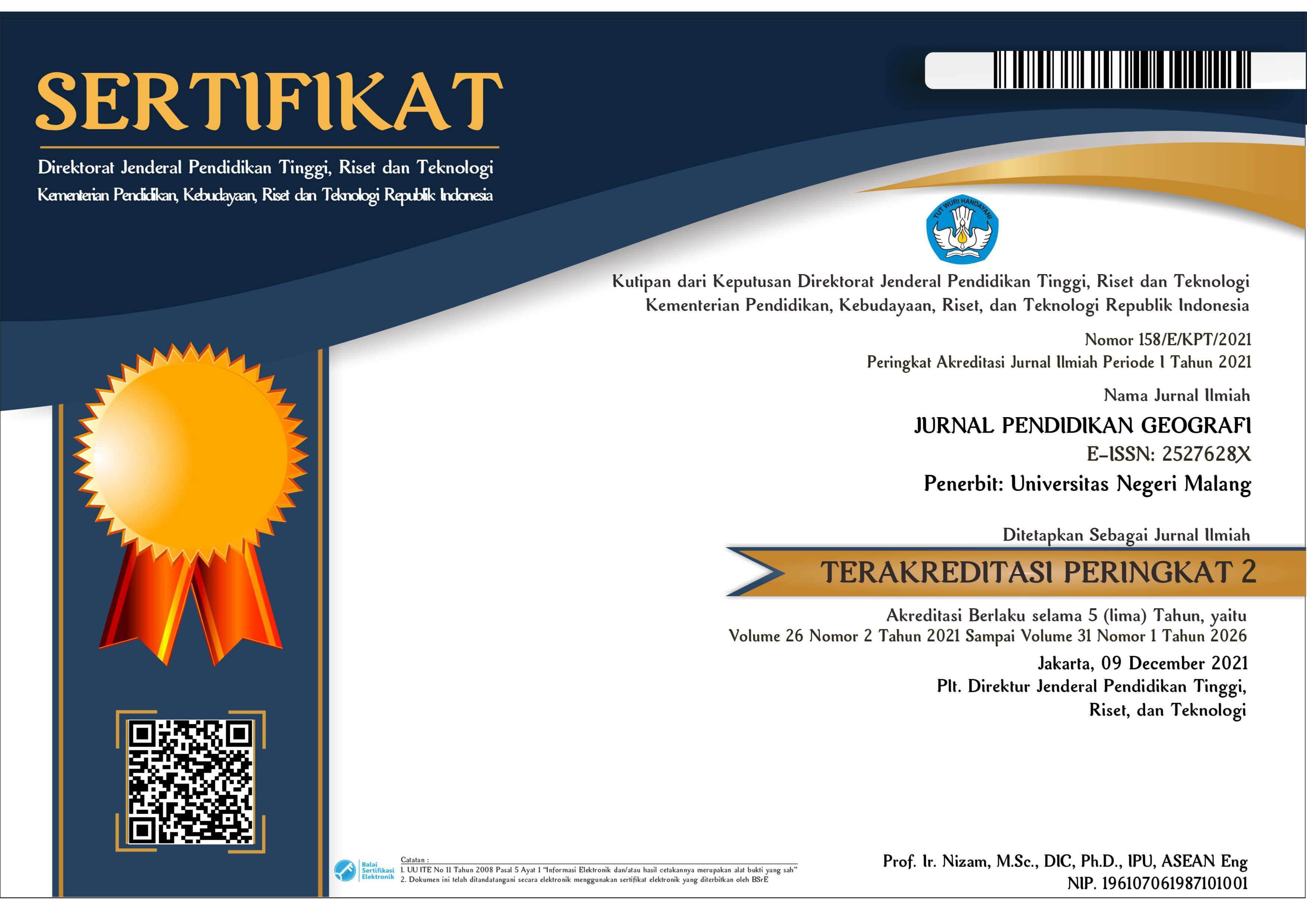Opak-Progo watershed’s potential for geography experiential learning
Abstract
Keywords
Full Text:
PDFReferences
Andreastuti, S. D., Newhall, C., & Dwiyanto, J. (2006). Menelusuri kebenaran letusan gunung merapi 1006. Indonesian Journal on Geoscience, 1(4), 201–207.
Arent, E., & Thesalonika, E. (2023). Conceptual live-in based geography learning model to develop environmentally caring attitudes and social skills. International Conference on Social Knowledge Sciences and Education (ICSKSE 2023), 343–355. Atlantis Press.
As’ari, R., Rohmat, D., Ningrum, E., & Yani, A. (2022). Zoning based on the functions of the geography education field laboratory in the galunggung mountain area, west java-indonesia. IOP Conference Series: Earth and Environmental Science, 1089(1), 12067. IOP Publishing.
Ashari, A. (2014). Distribusi spasial mataair kaitannya dengan keberadaan situs arkeologi di kaki lereng timur Gunungapi Sindoro antara Parakan dan Ngadirejo Kabupaten Temanggung. Prosiding Mega Seminar: Geografi untukmu Negeri 2014. Yogyakarta: Universitas Negeri Yogyakarta.
Ashari, A. (2022). The Role of Late Holocene Landscape Evolution in Affecting Settlement Distribution in Borobudur Basin, Central Java, Indonesia. Geography, Environment, Sustainability, 15(2), 13–22.
Ashari, A., Purwantara, S., Arif, N., & Widodo, E. (2021). Spatial evolution of the river valleys under the influence of active volcano: A case of Merapi volcanic plain. Quaestiones Geographicae, 40(3), 45–64.
Ashari, A., Wardoyo, M. A. I., Jamaludin, S., Kharisma, K., & Rosa, A. F. (2021). Potensi air sungai di sebagian bentuklahan kaki Vulkan Merapi pada Mangsa Karo Tahun 2020. Jurnal Geografi, Geografi dan Pengajarannya, 19(1), 35–48.
Ashari, A., & Widodo, E. (2019). Hidrogeomorfologi dan potensi mata air lereng barat daya Gunung Merbabu. Majalah Geografi Indonesia, 33(1), 48–56.
Bemmelen, R. W. V. (1949). The geology of Indonesia, Vol IA general geology of Indonesia and adjacent archipelagoes. Government Printing Office.
Bronto, S., Ratdomopurbo, A., Asmoro, P., & Adityarani, M. (2014). Longsoran raksasa Gunung Api Merapi Yogyakarta-Jawa Tengah. Jurnal Geologi dan Sumberdaya Mineral, 15(4), 165–183.
Carneiro, R., & Draxler, A. (2008). Education for the 21st century: Lessons and challenges. European Journal of Education, 43(2), 149–160.
Denty, A. (2023). Peringkat Indonesia pada PISA 2022 naik 5-6 posisi dibanding 2018. Retrieved from https://www.kemdikbud.go.id/main/blog/2023/12/peringkat-indonesia-pada-pisa-2022-naik-56-posisi-dibanding-2018
Elwood, S. A. (2004). Experiential learning, spatial practice, and critical urban geographies. Journal of Geography, 103(2), 55–63.
Ervin, M., Anafi, M. A., Arif, A., Puspita, H. R. A., Dewi, A. N., & Ashari, A. (2022). Hydrogeomorphology of spring at the junction of Sumbing-Sindoro Twin Stratovolcanoes, Central Java. IOP Conference Series: Earth and Environmental Science, 1089(1), 12022. IOP Publishing.
Fadjarajani, S., & As’ ari, R. (2021). Utilization of local landscape for educational field laboratory geography. Review of International Geographical Education Online, 11(3), 1014–1020.
Fenneman, N. M. (1909). Problems in the teaching of physical geography in secondary schools. Journal of Geography, 7(7), 145–157.
Gertisser, R., Charbonnier, S. J., Keller, J., & Quidelleur, X. (2012). The geological evolution of Merapi volcano, Central Java, Indonesia. Bulletin of Volcanology, 74, 1213–1233.
Gomez, C., Janin, M., Lavigne, F., Gertisser, R., Charbonnier, S., Lahitte, P., … Degroot, V. (2010). Borobudur, a basin under volcanic influence: 361,000 years BP to present. Journal of Volcanology and Geothermal Research, 196(3–4), 245–264.
Handrianto, C. (2012). Internalisasi filosofis pendidikan “ alam takambang jadi guru ” dalam menghadapi permasalahan pendidikan kontemporer. Seminar Antar Bangsa Mahasiswa Silang Budaya 2012.
Iftode, D. (2019). Generation Z and learning styles. SEA–Practical Application of Science, 7(21), 255–262.
Ives-Dewey, D. (2009). Teaching experiential learning in geography: Lessons from planning. Journal of Geography, 107(4–5), 167–174.
Januszewski, A., & Molenda, M. (2013). Educational technology: A definition with commentary. Routledge.
Jiusto, S., & DiBiasio, D. (2006). Experiential learning environments: Do they prepare our students to be self‐directed, life‐long learners? Journal of Engineering Education, 95(3), 195–204.
Knight, J., & Harrison, S. (2020). Physical geography, human geography, and geographies in the anthropocene. In A. Kobayashi (Ed.), International Encyclopedia of Human Geography, Second Edition. Elsevier.
Lambert, D., & Reiss, M. J. (2016). The place of fieldwork in geography qualifications. Geography, 101(1), 28–34.
Lavigne, F., Thouret, J. C., Voight, B., Suwa, H., & Sumaryono, A. (2000). Lahars at Merapi volcano, Central Java: An overview. Journal of Volcanology and Geothermal Research, 100(1–4), 423–456.
Markuszewska, I., Tanskanen, M., & Subirós, J. V. (2018). New ways to learn geography–challenges of the 21st century. Questiones Geographicae, 37(1), 37–45.
McPhee, S., & Przedpelska, S. (2018). Experiential learning, community engagement, and student experience: Undergraduate field school course in rural British Columbia. The Canadian Geographer/Le Géographe Canadien, 62(3), 372–383.
Meksangsouy, P., Nipithwittaya, S., & Losiri, C. (2020). Guidelines for fieldwork activities in environmental geography: A case study of the east of Thailand. Journal of Letters, 49(1), 146–161.
Mellor, A. (1991). Experiential learning through integrated project work: An example from soil science. Journal of Geography in Higher Education, 15(2), 135–149.
Mulyaningsih, S., Sampurno, S., Zaim, Y., Puradimaja, D. J., Bronto, S., & Siregar, D. A. (2006). Perkembangan geologi pada kuarter awal sampai masa sejarah di dataran Yogyakarta. Indonesian Journal on Geoscience, 1(2), 103–113.
Murwanto, H, Gunnell, Y., Suharsono, S., Sutikno, S., & Lavigne, F. (2004). Borobudur monument (Java, Indonesia) stood by a natural lake: Chronostratigraphic evidence and historical implications. The Holocene, 14(3), 459–463.
Murwanto, Helmy, & Purwoarminta, A. (2015). Rekonstruksi danau purba Borobudur dengan pendekatan spasiotemporal. Limnotek: Perairan Darat Tropis di Indonesia, 22(2), 106–117.
Newhall, C. G., Bronto, S., Alloway, B., Banks, N. G., Bahar, I., Del Marmol, M. A., … Miksic, J. N. (2000). 10,000 years of explosive eruptions of Merapi Volcano, Central Java: Archaeological and modern implications. Journal of Volcanology and Geothermal Research, 100(1–4), 9–50.
Pannekoek, A. J. (1949). Outline of the geomorphology of Java.
Purwantara, S., Ashari, A., & Ibrahim, M. H. Bin. (2020). The characteristics of infiltration on the southern flank of Merapi Volcanic plain, Yogyakarta, Indonesia. GEOMATE Journal, 19(74), 201–209.
Ratih, S., Awanda, H. N., Saputra, A. C., & Ashari, A. (2018). Hidrogeomorfologi mataair kaki Vulkan Merapi bagian selatan. Geo Media: Majalah Ilmiah dan Informasi Kegeografian, 16(1), 25–36.
Santosa, L. W. (2016). Keistimewaan Yogyakarta dari sudut pandang geomorfologi. UGM PRESS.
Schlee, R. P., Eveland, V. B., & Harich, K. R. (2020). From millennials to Gen Z: Changes in student attitudes about group projects. Journal of Education for Business, 95(3), 139–147.
Seemiller, C., Grace, M., Campagnolo, P. D. B., Alves, I. M. D. R., & De Borba, G. S. (2019). How generation Z college students prefer to learn: A comparison of US and Brazil students. Journal of Educational Research and Practice, 9(1), 349–368.
Sudradjat, A., Syafri, I., & Paripurno, E. (2010). The characteristics of lahar in Merapi Volcano, Central Java as the indicator of the explosivity during holocene. Jurnal Geologi Indonesia, 6(2), 69–74.
Sugiharyanto, S. (2007). Kelayakan wilayah Perbukitan Jiwo sebagai laboratorium alam untuk praktik kerja lapangan geografi fisik mahasiswa Jurusan Pendidikan Geografi. Geo Media, Majalah Ilmiah dan Informasi Kegeografian, 5(1), 1–12.
Sutikno, S., LW, W., Kurniawan, A., & Purwanto, T. H. (2007). Kerajaan Merapi: Sumberdaya alam dan daya dukungnya. Yogyakarta: Universitas Gadjah Mada.
Tadaki, M. (2020). Critical physical geography. In International Encyclopedia of Human Geography, Second Edition. Elsevier.
Tanudirjo, D. A., Yuwono, J. S. E., & Adi, A. M. W. (2019). Lanskap spiritual Situs Liyangan. Berkala Arkeologi, 39(2), 97–120.
Verstappen, H. T. (2013). Garis besar geomorfologi Indonesia: Studi kasus dalam geomorfologi tropis wilayah tektogen: Dilengkapi dengan peta geomorfologi skala 1: 5.000. 000. Gadjah Mada University Press.
Wardoyo, M. A. I., & Khotimah, N. (2021). Hidrogeomorfologi mata air stratovolkano di area Celah Selo Jawa Tengah. Geo Media: Majalah Ilmiah dan Informasi Kegeografian, 19(2), 136–148.
DOI: http://dx.doi.org/10.17977/um017v29i12024p78-94
Refbacks
- There are currently no refbacks.
Copyright (c) 2024 Jurnal Pendidikan Geografi: Kajian, Teori, dan Praktek dalam Bidang Pendidikan dan Ilmu Geografi

This work is licensed under a Creative Commons Attribution-ShareAlike 4.0 International License.
Jurnal Pendidikan Geografi: Kajian, Teori, dan Praktek dalam Bidang Pendidikan dan Ilmu Geografi is licensed under Creative Commons Attribution-ShareAlike 4.0 International License,
JPG Indexed By:
View My Stats








12.png)
